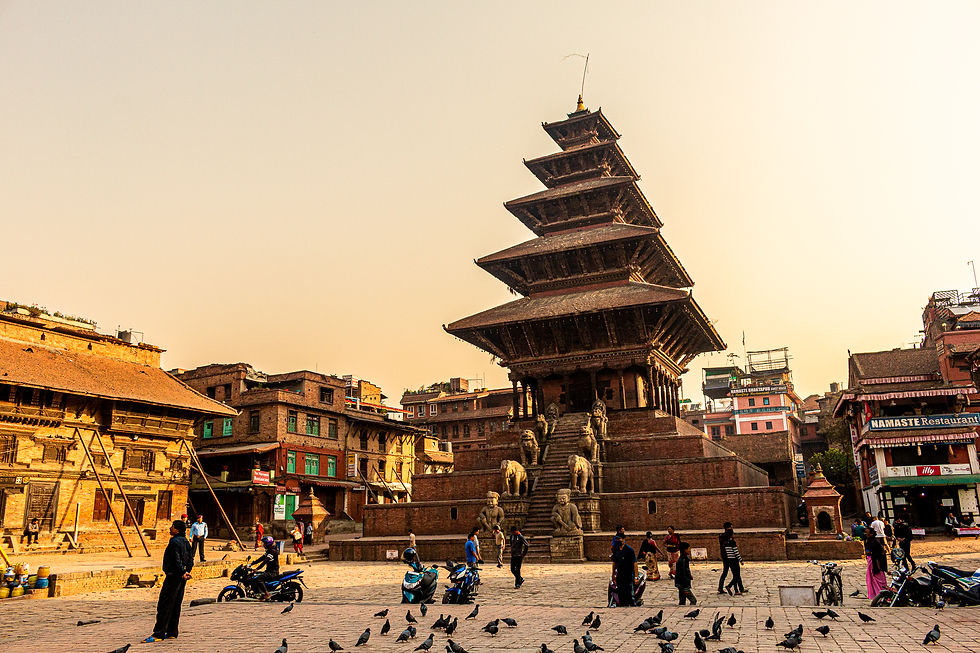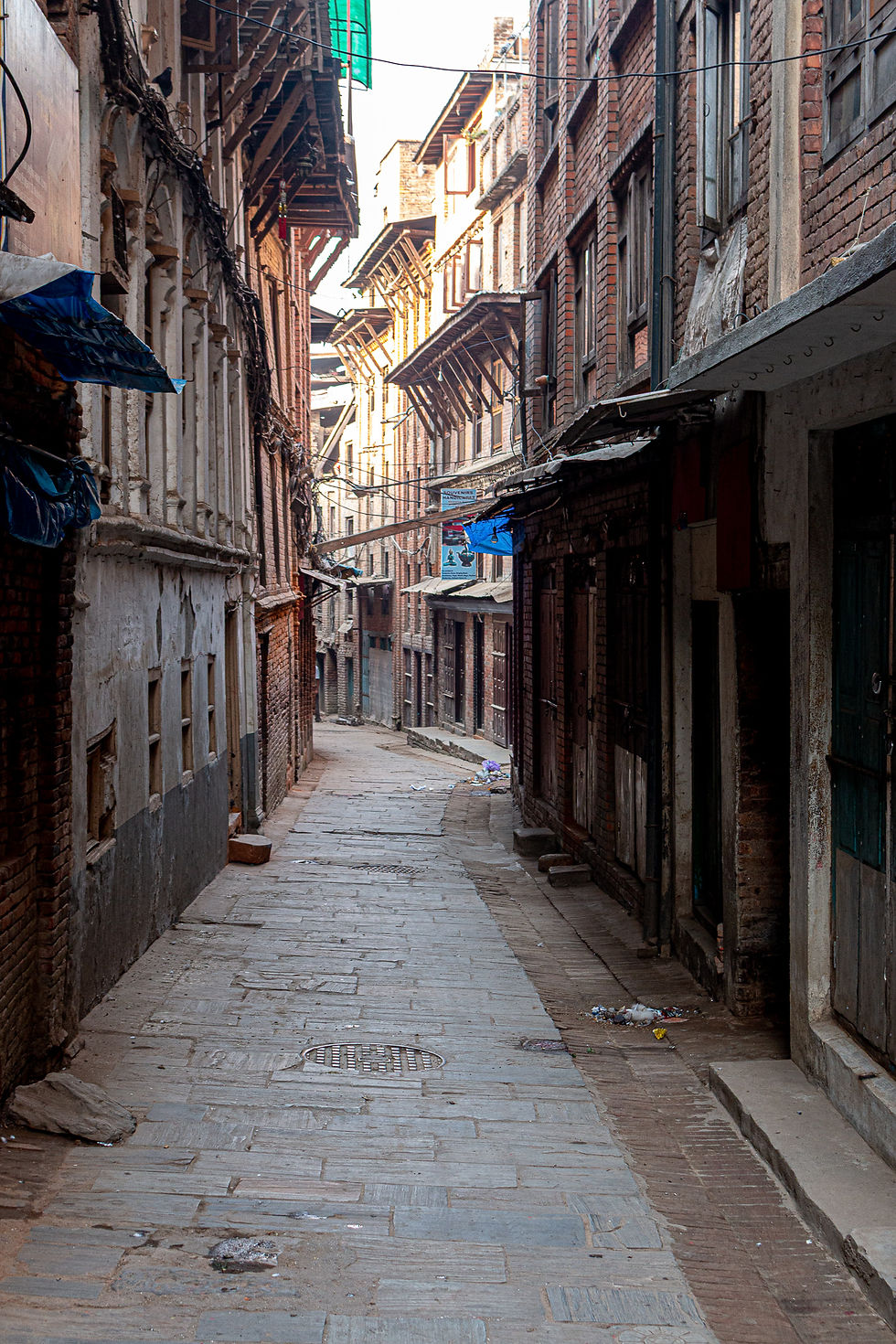Wandering Through Bhaktapur: A City That Waits for You
- Rand Blimes

- May 14
- 5 min read
Updated: Oct 24

If Kathmandu is the Nepalese city that captured my heart, Bhaktapur, with its medieval alleyways and stunning Durbar Square, has laid claim to my soul. If you love atmospheric cities, where the city itself is the main draw, then wandering through Bhaktapur is definitely for you.
The City of Devotees
There are cities that announce themselves with noise and motion, and there are cities that wait for you—still, patient, breathing history through every brick.
Bhaktapur is the latter.
Once the royal seat of the Kathmandu Valley, Bhaktapur thrived when the Malla kings divided the land into three kingdoms, each eager to outshine the others in devotion, beauty, and stone. Kathmandu got the political power. Patan got the artisans. And Bhaktapur? Bhaktapur got the poets.
And those poets built temples that seem to hold their breath in reverence for the place, filled with carved windows, leaning pagodas, sunlit courtyards. And the poetry of those temples—and the city that surrounds them—somehow endures.
The city’s name means City of Devotees, and you feel it. Not just in the temples, which seem to rise out of the earth like memory, but in the rhythm of daily life: a woman sweeping the street at dawn, a man laying marigolds on a stone deity worn smooth by centuries of touch, the pure sound of a bell ringing out, bouncing off the walls that make each narrow street and alley.

Bhaktapur is a city that has prayed longer than most countries have existed.
Time moves differently here. It’s not that it resists the modern world—it just doesn’t chase it. The wi-fi may falter, but the light through the lattice windows at 4:00 p.m. will break your heart a little. And somehow, that feels like the better bargain.

After the Cracks Came
When the earthquake hit Nepal in April 2015, Bhaktapur cracked—not just at its edges, but at its heart. Temples that had stood for centuries fell in seconds. Bricks, once part of sacred geometry, lay broken in piles. The proud tilt of Nyatapola still held, but too many others did not. Entire courtyards were turned to rubble, and homes folded in on themselves as if exhaling one final time.
The toll on the city’s heritage was terrible. The toll on the city’s humanity was worse.

Walking through the city not long after was like stepping into a kind of sacred hush. Dust still hung in the air. The silence was not peaceful—it was stunned. Families sorted through bricks that had once been their doorways. A woman swept the steps of a shrine that no longer had a roof. Someone had draped prayer flags across fallen stone, as if reminding the gods where they were needed.
And yet, Bhaktapur endured. Not untouched. Not undamaged. But enduring. Some temples were gone. Some were being slowly stitched back together with scaffolding and hope. Others leaned just slightly, the way elderly people do when they’ve seen too much and kept going anyway.
The soul of the city didn’t collapse. It just sat for a while in the dust, hands folded, waiting.
Wandering through Bhaktapur
Bhaktapur has a fairly large population by most official counts, but it never feels that way. It feels like a small town that was built brick by brick over the centuries, a place that keeps its center hidden just long enough to make finding it feel earned.

The beauty of Bhaktapur is not in checking off sights. It’s in wandering. The alleyways here don’t just connect one place to another—they are the place. Narrow, uneven, and shadowed by centuries-old buildings, they wind through small courtyards where someone is always setting out fresh pottery to dry in the sun, the rows catching light like they’ve been laid out for the gods.

And then, without so much as a drumroll, the alley widens—just a little smugly—and lays out Durbar Square like it’s been saving the best for last. It waits for—and expects—your appreciation.
It isn't hard to give.
You step from the hush of stone walls into the expanse of the square, and it’s like the city inhales. Suddenly there is space. Light. You feel almost overloaded trying to decide where to look: the towering silhouette of Nyatapola, or the stepped tiers of a temple you don't even know the name of—but it doesn't matter. You’ve arrived at the heart, not because you followed signs, but because you let the city guide you.
And it always does.
Bhaktapur never shouts for your attention. It lets you stumble into awe one quiet turn at a time.

The Price of Admission
There is a fee to enter Bhaktapur now—one that would’ve made my younger, threadbare self hesitate at the gate. It’s not cheap. But I paid it, and I’d pay it again. Some places are worth more than what they cost. And Bhaktapur, for all it has endured, still offers something most cities can’t: a sense that time, beauty, and devotion have conspired to build something quietly extraordinary—and then left it there, waiting for . . . something. Or maybe someone. Maybe even you?
Bhaktapur on My Mind
Bhaktapur doesn’t dazzle the way some cities do. It doesn’t flash lights or chase trends. It waits. It leans into the sun, lets the laundry flutter, lets the dust settle. And in that stillness, something remarkable happens: you slow down too. You start to notice the curve of a carved window, the echo of a footstep in a stone courtyard, the way incense hangs in the air long after the offering is done.

It’s not just a place I’ve visited. It’s a place that has stayed with me—quietly, persistently, like the sound of a bell you didn’t realize was still ringing. And I don’t know if that’s what Bhaktapur does to everyone. But it’s what it did to me. Because travel is memory. And some places write themselves into you with brick and light and time.
NOTE: most visitors to Bhaktapur come on daytrips from Kathmandu. To get the real Bhaktapur, with the atmosphere that I tried to capture in this post, spend the night here. Or several nights.









Comments